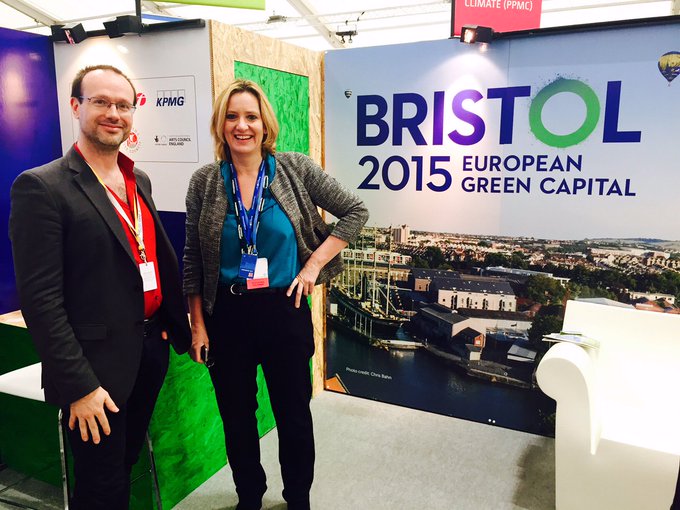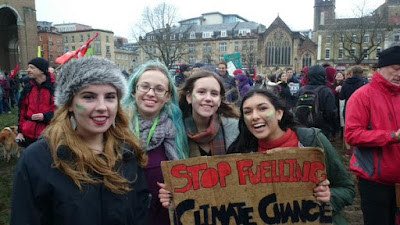This is a report from the very first event in the Green and Black partnership between Ujima Radio, Bristol Green Capital Partnership and the Cabot Institute. Ujima had been leading on the Conversation for the previous year, and this particular event was the catalyst for a three-year (and growing) partnership that was the foundation for the award-winning and celebrated Green and Black Ambassadors.
This Green and Black Conversation involved several members of Bristol’s Black and Minority Ethnic (BME) community and organisations. It was held in partnership with Bristol Green Capital Partnership (Gary Topp), University of Bristol (Hayley Shaw, Cabot Institute & Kat Wall, Policy Institute) and sponsored by the Cabot Institute whose Director Professor Rich Pancost addressed the group. The campaign has political support from Mayor George Ferguson and also Marvin Rees who attended the forum with European Member of European Parliament Claire Moody.
Our new volunteer Helly Dudley, Broadcast Assistant on Ujima’s Old Skool Cruising Show (Monday 4-6) with Roger Griffith who was co-facilitator with Julz attended her first community engagement event and here is her blog.
The Report of the Green and Black Conversation, written by Roger, can be read here.
———————————
| The Green and Black Conversation |
Arriving at St Werburgh’s community centre I knew I was going to be getting involved in discussions about being ‘Green/Environmental’ and how this is linked to the BME community in Bristol. However, I wasn’t sure what would be discussed, how they would be viewed and spoken about.
From the get-go I realised that this is extremely important to many members of the BME community as there was enthusiasm for living in an environmentally beneficial lifestyle and also a feeling of a lack of support which members of the BME community feel they are receiving from the campaign. Although Bristol is European Green capital, there is a divide occurring within the city and certain communities feel they are being excluded by Bristol European Green Capital from this campaign.
We first looked at the use of language and the ways in which this can be limiting to people of all ages and ethnicities. Not only do language barriers prevent certain communities from getting involved but it also prevents them from knowing how to help and giving them a sense of self-responsibility. When one member of the group declared they didn’t know what ‘buying organic’ meant this created a murmur of agreement throughout the rest of the group as few of us were able to define what ‘organic’ meant. If you, like me, are unsure of the term ‘organic’ then the definition is – ‘(of food or farming methods) produced or involving production without the use of chemical fertilizers, pesticides, or other artificial chemicals.’
If the Green agenda wants to get all of Bristol’s residents on board to help the environment then they need to change the way in which they portray their methods of being sustainable and as we explored language is just one of those methods.
Another issue raised throughout the day was there was a belief that it was seen as an elitist campaign which directs its messages mainly to a white middle-class demographic. One attendee pointed out that, Gloucester Road is covered with Green campaign posters, Stapleton Road was left untouched. Why is it that the campaign is just aiming their agendas at the central zone of Bristol and neglecting the rest of its communities?
Kat Wall, who works with the University of Bristol and helped set up this discussion, mentioned that she had been to an environmental meeting and was shocked by the lack of BME members present. When she questioned the organiser of the event why this was the case they just replied that they had sent out the necessary invites but no one turned up. When this was put to the rest of the group there was an immediate response that the main reason they don’t attend these events is because they are tired of time and time again going to the same talks and making their input but never actually being heard or have their opinions taken on board.
There seems to be a lack of conversations between communities and those in power. To quote a member of Bristol’s Bus Boycott and activist and former farmer Roy Hackett ‘nobody ever asks me’ so if Bristol City Council and others don’t start listening to the ideas and needs of their own citizens then how are we as tax-paying citizens supposed to be able to get involved . One attendee mentioned that if her house was better insulated then she would be able to use less gas and her bills would decrease and she would be able to find the money to buy organic foods.
How can our city expect to stay regarded as a great city when we are cutting out members of our society from joining this campaign and others? We need to change our way of approaching the environmental issues and instead of forcing change onto communities we need to ask the residences of Bristol what they need for change.
We need to carry on having these discussions with each other, and those in power on what the people need in all communities not just the city centre. With the United Nations COP21 meeting taking place over the next 10 days in Paris, discussing climate change we need to now, more than ever, change our way of approaching this subject; and this can be done by including all members of our communities and tackling environmental issues together.
I really enjoyed attending this event and, by the enthusiasm and energy in the room, so did the other participants I believe that it was a conversation that was desperately needed so communities understand that this isn’t just an environmental issue but a social one that needs tackling. It is essential we work together and listen to one another to create new ideas of how to better enhance Bristol’s sustainability.
—————————————-
This event took place at St Werburgh’s Community Centre in Bristol on 30 November 2015.
This blog was written by Helly Dudley, follow on Twitter @helena_dudley
Follow @ujimaradio.com @julzbrizzle and Roger Griffith @rogerg44.
The Green and Black initiative is a campaign ran by Ujima Radio to raise awareness within the Black & Minority Ethnic (BME) community about the environment and includes Bristol European Green Capital 2015 and beyond. The campaign has been led by Ujima presenter Julz Davis AKA Mistri and has included live broadcasts, debates, featured radio shows and ideas and brings people from marginalised communities into the discussions. This can include cooking tips, exercise and health, climate change across the African and Asian diaspora or heavy air-pollution from the M32 corridor that divides St Pauls and Easton.
Read more about how the Cabot Institute is working with the BME communities around the legacy of the European Green Capital year – see project Green and Black- An alternative green capital.
Most importantly, follow @ketibuahfoley @ZakiyaMedia, the Green and Black Ambassadors. The issues raised by the Green and Black initiative and conversation led to a coordinate effort to create a new form of collaborative partnership and to procure funding to support our community partners (from the ERC and NERC). It has been profiled by NERC and the final report from the Ambassadors pilot phase can be downloaded here.
















